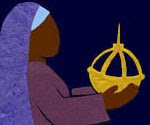The highlight for me was the Sunday morning events held at the Kirtland Temple, which Community of Christ very hospitably made available to us. I went early in the morning, sat in the garden on the temple grounds, and chanted most of D&C 109, the Kirtland Temple dedicatory prayer (minus some petitions to which I can't say "Amen" in good conscience). Then I attended a testimony meeting in the lower court of the temple, which was rather raw, as you might imagine. I gave the closing prayer, which went like this:
Holy God,The testimony meeting was followed by a devotional, near the end of which everyone stood to sing "The Spirit of God."
our spiritual forebears built this place to be a sanctuary of your holiness.
They built it in the faith and hope
that here you would endow them with power from on high,
so that they could go forth from this place in the power of your Spirit,
to carry out your work in the world.
Send us out in the power of your Spirit
to do your work,
to love and to serve,
to magnify our talents,
to be a blessing in the lives of others.
In Christ's name we pray, amen.
When we had toured the temple the day before, I'd felt underwhelmed by the building, which didn't look as "polished" and elegant as it does in photographs. (I suspect it's a trick of how the photos are lit.) But sitting in the temple this morning, during the devotional, I felt I better appreciated what a lovely building it is, white and full of sunlight. The pulpits are quite distinctive. And it was weird to think that Joseph and Emma and others actually sat in those pulpits or in these pews.
************
On a more sour note:
The devotional was attended by at least one LDS missionary couple from the historic Kirtland village, down the hill from the temple. I was surprised to see them there, and the more I think about it, the less pleasant I find that surprise. Their presence casts a shadow on the conference experience for me. A positive reading of their presence is that we're building bridges. A more suspicious reading is that this, like the Tabernacle invite to gay activists last Christmas, was a cheap way for the church to build goodwill. It was a cheap way to try to prevent further embarrassing protests outside their temples.
Unfortunately, I've seen too many people get screwed by church officials, myself included, not to be suspicious. The LDS Church is going to have to work a hell of a lot harder to win my trust. I feel like Prior in Angels in America: "Answer me: Inside. Bruises? . . . Come back to me when they're visible. I want to see black and blue, . . . , I want to see blood. Because I can't believe you even have blood in your veins till you show it to me."
I'm a little surprised to realize how angry I feel about this.
************
And then a sad, wistful note:
At the temple gift shop, I bought a lovely little illustrated history of Community of Christ whose coauthors included David Howlett and John Hamer, two young scholars I know. It made me feel jealous. David and John are doing work for Community of Christ that I would love to be doing for a liberal LDS Church, which of course doesn't exist. I've known for a decade that this is what I want; I accept that like most people who have lived and do live in this world, I can't have what I want. But I still feel jealous and sad and self-pitying about it.


